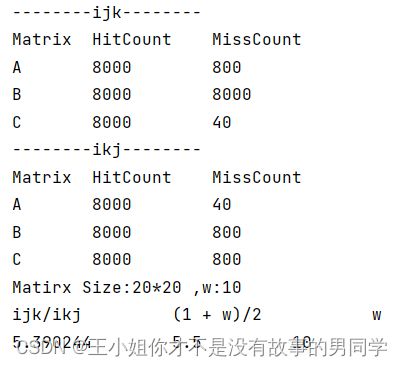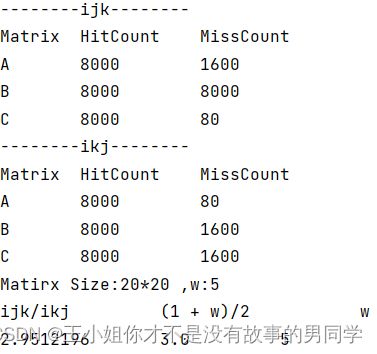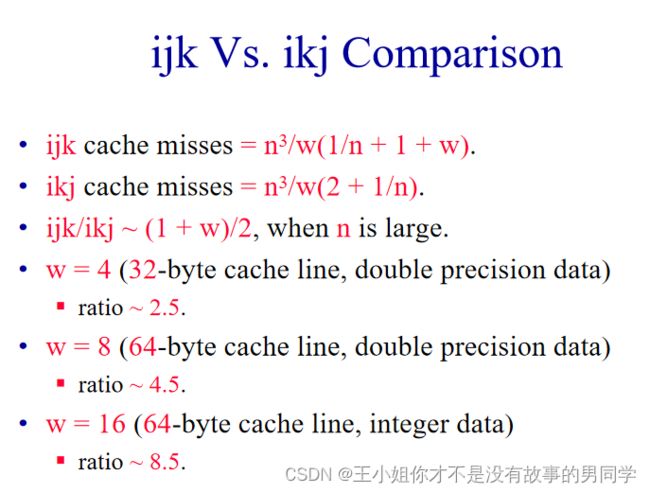【算法】ijk矩阵乘法性能分析
ijk矩阵乘法性能分析
文章目录
- ijk矩阵乘法性能分析
-
-
- 1. Problem description
- 2. Algorithom idea
-
- 2.1 get函数设计思路
- 2.2 set函数设计思路
- 3 Function model design
-
- 3.1 Matrix类实现
- 3.2 get函数实现
- 3.3 set函数实现
- 4. Test results and analysis
- 5. Project summary
-
1. Problem description
- 利用文件模拟cache缓存机制读写数据,将二维数组存储到文件中,并模拟对矩阵进行读写操作。操作要求为读取矩阵A、B,并输出A、B的乘积C。
- 改变cache大小
- 改变读取数据的顺序,即ijk、ikj
- 分析cache miss的次数与cache大小、读取数据顺序之间的关系
2. Algorithom idea
为了简化思路,我们可以先想想若二维数组在内存中是如何计算的,显而易见,当计算C=A*B
以ikj的顺序进行的时候,有:
for(int i=0;i<n;i++)
for(int k=0;k<n;k++)
for(int j=0;j<n;j++){
c[i][j] += a[i][k] * b[k][j];
}
我们可以在此基础上进行代理函数设计,将计算函数变为如下形式:
for(int i=0;i<n;i++)
for(int k=0;k<n;k++)
for(int j=0;j<n;j++){
C.set(i,j,B.get(k,j)*A.get(i,k)+ C.get(i,j));
}
因此我们要做的就是进行set、get函数的设计。
2.1 get函数设计思路
为了简化文件查找操作,我们在文件中没有必要以二维的形式存储数据,可以通过数学的方法将二维数组转换成一维数组,即:targetIndex = row * rowSize + col 。
我们只需要用两个变量记录目前 Cache 存储的下表范围( startIndex , endIndex )即可判断访存Cache访问是否命中——如果不在该范围内,直接去文件中读取 (targetIndex, targetIndex+cacheSize)对cache进行更新即可。
2.2 set函数设计思路
同get函数的实现思路类似,将二维下标变为一维记录。但是需要考虑脏位——当targetIndex不在cache中时,不能直接覆盖cache,而需要将在cache中已经被更改过的数据写回更新进外存,即文件中。
此处由于每次更新都是以一整个cache为单位,因此我们只为外存设置一个脏位,而不是为每个Unit设置。当dirty==true时,表明之前有一次 set 调用命中,对与外存映射的cache中数据进行修改。
3 Function model design
3.1 Matrix类实现
//缓存数组
int[] cache;
//矩阵的行数
int rowSize;
//矩阵列数
int colSize;
//缓存开始的行数
int startRow;
//缓存开始的列数
int startCol;
//缓存结束的行数
int endRow;
//缓存结束的列数
int endCol;
//缓存大小
int cacheSize;
//cache miss 次数
long cacheMissCount;
//cache 访问次数
long cacheCount;
//矩阵在磁盘中的位置
String matrixFilePath;
//缓存是否被写入过
Boolean dirty;
//是否整个矩阵都在内存当中
Matrix(int rowSize,int colSize,int cacheSize,String matrixFilePath) throws IOException {
this.colSize=colSize;
this.rowSize=rowSize;
this.cacheSize=cacheSize;
this.matrixFilePath=matrixFilePath;
cache=new int[cacheSize];
dirty=false;
endRow=-1;
endCol=-1;
File file=new File(matrixFilePath);
file.delete();
file.createNewFile();
createRandomMatrix();
}
3.2 get函数实现
int get(int row, int col)
{
if (row > rowSize || col > colSize)
try {
throw new Exception("row > rowSize || col > this->colSize");
} catch (Exception e) {
e.printStackTrace();
}
cacheCount++;
if (currentIndex(startRow, startCol) <= currentIndex(row, col) && currentIndex(row, col) <= currentIndex(endRow, endCol))
return cache[currentIndex(row, col) - currentIndex(startRow, startCol)];
else
{
cacheMissCount++;
readCache(row, col);
return cache[0];
}
}
void writeCache()
{
RandomAccessFile raf=null;
try{
raf = new RandomAccessFile(new File(matrixFilePath), "rw");
raf.seek((currentIndex(startRow, startCol)) * 4);
for (int i = 0; i < cacheSize; i++)
{
raf.writeInt(cache[i]);
}
}catch (Exception e){
e.printStackTrace();
}finally {
try {
raf.close();
}catch (IOException e){
e.printStackTrace();
}
}
}
3.3 set函数实现
void set(int row, int col, int value)
{
if (row > rowSize || col > colSize)
try {
throw new Exception ("row > rowSize || col > this->colSize");
} catch (Exception e) {
e.printStackTrace();
}
if (currentIndex(startRow, startCol) <= currentIndex(row, col) && currentIndex(row, col) <= currentIndex(endRow, endCol))
cache[currentIndex(row, col) - currentIndex(startRow, startCol)] = value;
else
{
cacheMissCount++;
readCache(row, col);
cache[0] = value;
}
dirty = true;
}
void readCache(int row, int col)
{
if (dirty)
{
writeCache();
dirty = false;
}
RandomAccessFile raf=null;
try{
raf = new RandomAccessFile(new File(matrixFilePath), "r");
raf.seek((currentIndex(row, col)) * 4);
for (int i = 0; i < cacheSize; i++){
//未知错误,暂时笨方法
if(raf.getFilePointer()+1>=raf.length())break;
cache[i]=raf.readInt();
}
startRow = row;
startCol = col;
endRow = cacheSize / rowSize + startRow;
if ((cacheSize % rowSize - 1 + startCol) > colSize)
{
endRow++;
endCol = cacheSize % rowSize - 1 + startCol - colSize;
}
else
{
endCol = cacheSize % rowSize - 1 + startCol;
}
}catch (Exception e){
e.printStackTrace();
}finally {
try {
raf.close();
}catch (IOException e){
e.printStackTrace();
}
}
}
4. Test results and analysis
以下是实验结果截图:
以下是理论值分析:
将理论值和实验值比较,发现基本吻合。
5. Project summary
在本次实验中,最大的困难是如何通过文件读写操作来模拟cache机制。在文件中,需要找到定义文件上一次读写位置的方法,在每次cache miss后找到该位置再进行读写。我的方法是使用一行来表式一个矩阵,并且通过记录矩阵读取的位置来定位文件的位置。





